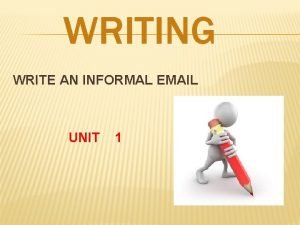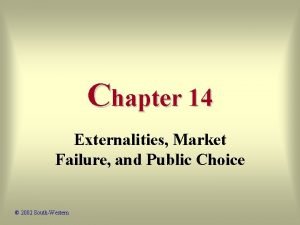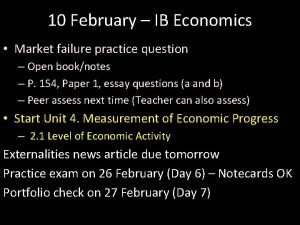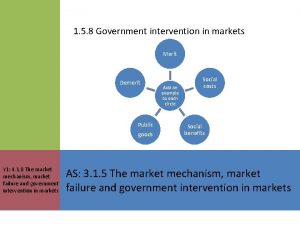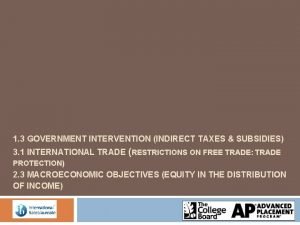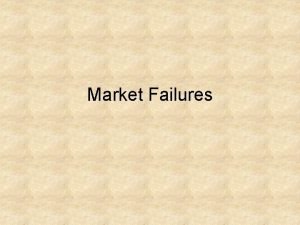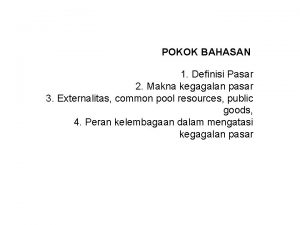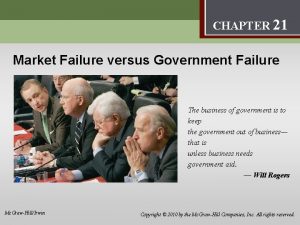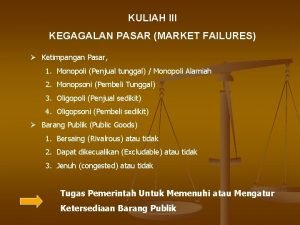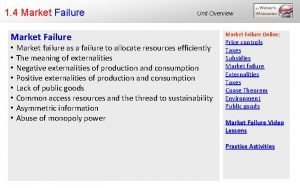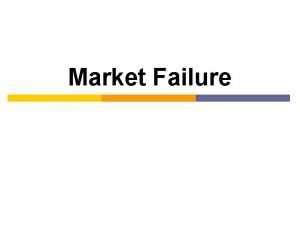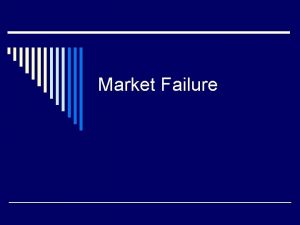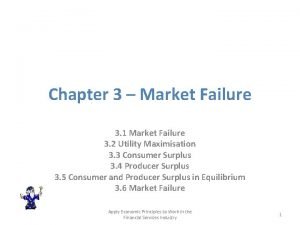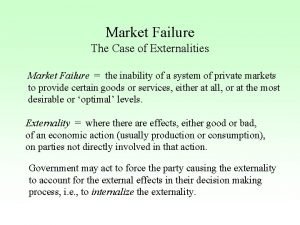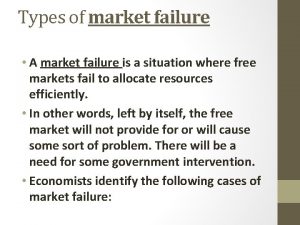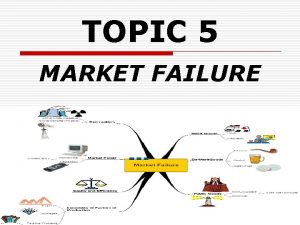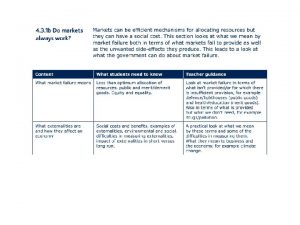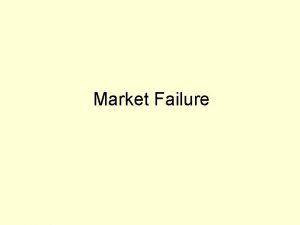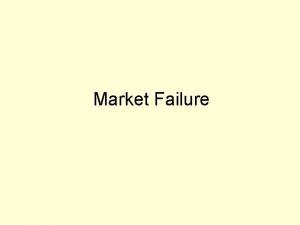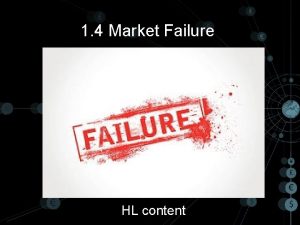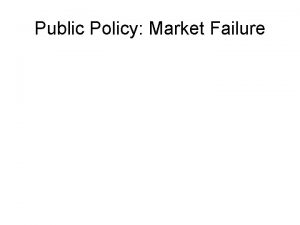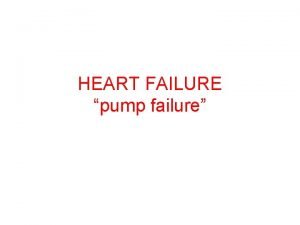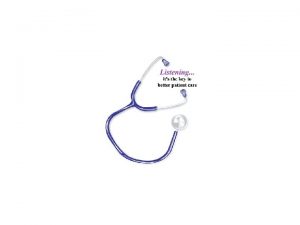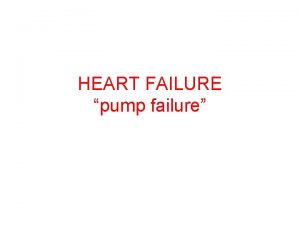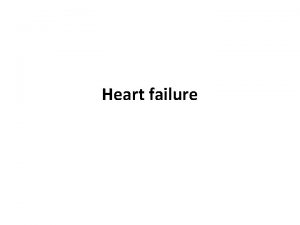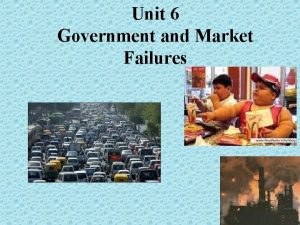1 4 Market Failure Unit Overview Market failure









































- Slides: 41

1. 4 Market Failure • • Unit Overview Market failure as a failure to allocate resources efficiently The meaning of externalities Negative externalities of production and consumption Positive externalities of production and consumption Lack of public goods Common access resources and the thread to sustainability Asymmetric information Abuse of monopoly power Market Failure Online: Price controls Taxes Subsidies Market failure Externalities Taxes Coase Theorem Environment Public goods Market Failure Video Lessons Practice Activities Microeconomics Glossary

1. 4 Market Failure Introduction to Market Failure Up to this point in the course we have focused on the efficiency of the free market. • • • Markets are efficient because, when in equilibrium, they are allocatively efficient The socially optimal amount of output will be produced: Marginal Social Benefit will equal Marginal Social Cost When governments intervene in free markets (indirect taxes, subsidies, price controls), resources become misallocated and there is a loss of total welfare. Market Failure Definition: Markets are NOT always efficient. There are several circumstances under which resources will be mis-allocated by the free market. In other words, either too much of a good will be produced or not enough will be produced by the free market. Examples of market failures include: • Negative Externalities of Production and Consumption • Positive Externalities of Production and Consumption • Lack of Public Goods • Common Access Resources and the Tragedy of the Commons • Asymmetric Information • Abuse of Monopoly Power Blog Post: A video and audio introduction to Market Failure

1. 4 Market Failure Externalities One way markets fail to achieve allocative efficiency arises from the existence of externalities in the market for a god Externality Definition: An externality exists any time the production or consumption of a good creates spillover benefits or costs on a third party not involved in the market. In such cases, resources will either be under-allocated (positive externalities) or over-allocated (negative externalities) towards the production of certain goods. Examples of Positive Externalities Examples of Negative Externalities Receiving a college education makes the consumer more likely to contribute to the well-being of society as a whole Driving sports-utility vehicles contributes to traffic and contributes more to global warming Riding bicycles to work reduces congestion on the roads and makes for less traffic for everyone else Producing electricity using coal creates greenhouse gas emissions and air pollution Getting vaccines against communicable diseases reduces the chance you will get others sick Smoking cigarettes contributes to lung disease among not just the smokers, but those who suffer from second-hand smoke (known as merit goods) (known as demerit goods)

1. 4 Market Failure Externalities Negative Externalities of Production In each of the examples from the table on the previous slide, there is a good or service being produced or consumed by one group of people which creates either costs or benefits for another group of people. We will examine four types of externalities now, beginning with… Negative Externalities of Production: These arise when the production of a good creates spillover costs P on a third party, which is often times the environment as a whole. The Marginal Social Cost of Pso producing a good is greater than the Marginal Private Cost of producing it… Example: A polluting Pe industry. In the graph… • MPC = The private costs of producing the good • MSC = the cost to society of producing the good, includes the MPC plus any external costs • Qe = the actual output in the market • Qso = The socially optimal output in the market • Pe = the equilibrium price in the market • Pso = the socially optimal price if all social costs were considered in the good’s production Polluting industry MSC S=MPC distance b/w MPC & MSC = external costs D=MSB Qso Qe Q Qe > Qso: resources are over-allocated towards the polluting industry

1. 4 Market Failure Externalities Negative Externalities of Production A polluting industry creates costs for society that are not paid by the polluting firm. These external costs of production may include: Polluting MSC Greenhouse gas emissions which contribute to P S=MPC industry global warming • Air pollution MSC>MSB • Contributions to lung disease and cancer rates Pso among the population Welfare Loss Pe • Water pollution which destroys fish stocks • Soil contamination which harms agricultural productivity. The existence of all these externalities creates a social cost that exceeds the private cost! D=MSB • As a result, there is a loss of total welfare in the Qso Qe industry represented by the gray triangle. Q • At the equilibrium output of Qe, the marginal social cost exceeds the marginal social benefit, meaning… • Too much of the good is being produced by the free market! This is a market failure!

1. 4 Market Failure Externalities Video Lesson INTRODUCTION TO MARKET FAILURE AND NEGATIVE EXTERNALITIES OF PRODUCTION

1. 4 Market Failure Externalities Negative Externalities of Consumption Some goods are over-consumed by the free market. This would be the case if the process of consuming a good created spillover costs on a third party. The classic example of a negative consumption externality is cigarettes. Cigarette P Market Consider the market seen here: S=MSC • • • The Marginal Private Benefit (MPB) of smoking cigarettes is greater than the Marginal Social Benefit (MSB) Smoking creates costs (negative benefits) on nonsmokers, so society benefits as a whole less than Pe the smokers themselves Pso There are no externalities in the production of cigarettes, so the supply curve represents the private costs and the social costs. The equilibrium price (Pe) is greater than the price would if demand represented the social benefits of smoking (Pso) The equilibrium quantity (Qe) is greater than the socially optimal quantity (Qso) =MPC distance b/w MSB & MPB = external costs MSB Qso Qe D=MPB Q Qe > Qso: resources are over-allocated towards the cigarette industry

1. 4 Market Failure Externalities Negative Externalities of Consumption Smoking harms third parties who do not buy or sell cigarettes, therefore this is a negative consumption externality. Notice on the graph: • At Qe (the actual quantity of cigarettes consumed in a free market), the MSC of smoking exceeds the MSB. • Too many cigarettes are being produced and consumed at Qe, resulting in a loss of total welfare equal to the gray triangle. Resources will be over-allocated towards the production and consumption of cigarettes by the free market. This is a market failure! P Cigarette Market S=MSC =MPC Pe Welfare Loss Pso MSC>MSB Qso Qe Blog Post: Internalizing externalities-Zurich’s expensive garbage D=MPB Q

1. 4 Market Failure Externalities Video Lesson NEGATIVE EXTERNALITIES OF CONSUMPTION

1. 4 Market Failure Externalities Government Responses to Negative Externalities Whenever a market fails by allocating too many resources towards the production of the good, the government can potentially improve market efficiency by intervening to reduce the quantity produced and consumed to a more socially optimal level (where MSB=MSC). Methods a government might take to correct a negative externality include: • Corrective taxes: This is a per-unit tax on a good meant to reduce the supply, increase the price, and reduce the quantity demanded to a more socially optimal level. Unlike a tax on a good that is produced efficiently by the free market, this is a corrective tax because it is meant to correct a failing market and help the market achieve a higher level of efficiency. • Regulation/Legislation: Laws that limit the quantity of a good produced or require it to be produced in an environmentally friendly way may increase the costs of production to firms and reduce the quantity to a more socially optimal level. • Banning: Many goods which create negative externalities are simply banned. Examples include: Drinking among minors, narcotics, prostitution, automatic weapons, etc… • Tradeable Permits: Issuing permits to producers of goods which create negative environmental externalities will create a physical limit on the amount of pollution or of the harmful activity, reducing the overall cost to society of the activity.

1. 4 Market Failure Externalities Government Responses to Negative Externalities – Corrective Taxes A tax meant to correct a market failure is sometimes referred to as a Pigouvian Tax, after the economist Arthur Pigou, who first proposed using taxes to reduce the output of harmful goods. • • P Recall that a tax is a determinant of supply, s A tax on a good which created externalities of production or consumption will increase the marginal private costs of production and reduce the supply to a level closer to the marginal social costs (which include all external costs). Polluting industry Pe 1 Pe Qso Qe The tax reduces the supply of both P goods, causing the S=MPC equilibrium price to rise and the quantity demanded to fall. If Pe 1 the size of the tax Pe reflects the size of the external costs, Pso then the new equilibrium output D=MSB (Qe) will equal the socially optimal level Q of output (Qso) MSC=Sw/tax Cigarette Market Sw/tax MSB Qso Qe S=MSC D=MPB Q

1. 4 Market Failure Evaluation of Corrective Taxes Externalities Corrective taxes are a popular response to negative externalities among economist, but among policy-makers, they are rarely popular. Some arguments against corrective taxes include: • Higher costs for producers: Producers face higher costs, and therefore will reduce their output of the goods being taxed. This is bad for business. • Higher prices for consumers: Consumers of the goods being taxed face higher prices, reducing consumer surplus and the real incomes of households. For some goods (such as electricity) this could place a major financial burden on households. • Less employment: As the taxed industries reduce their output, they may be forced to lay off workers, increasing unemployment in the economy. • Loss of competitiveness in global market: This is a major one. Policy-makers fear that if they impose taxes on their nation’s producers, but other nations’ governments do not impose taxes on their producers, then the domestic industries will suffer while foreign producers thrive. International cooperation on the implementation of corrective taxes could eliminate this problem, but there have been very few examples of such cooperation.

1. 4 Market Failure Externalities Government Responses to Negative Externalities – Tradeable Permits A second method for reducing the negative externalities arising from production or consumption of certain goods is the use of tradeable permits. • For example, in Europe there is a market for permits to emit carbon dioxide, a greenhouse gas widely believed to contribute to global warming. Here’s how it works… Market for CO 2 emissions permits 1. A government or multi-national governing body issues or Price per auctions off permits to polluting industries which allow them pollution to emit a certain amount of carbon. permit 2. Some firms pollute beyond their permitted amount, so will either have to acquire more permits or reduce their emissions. 3. To acquire more permits, they must buy them from in the market from firms that do not need all of their permits 4. The supply of permits is fixed and determined by the government, the demand for permits therefore determines the price of pollution. The more firms want to pollute, the more expensive it becomes to pollute. 5. There is a strong incentive for firms to reduce their emissions, because they can then sell the permits they do not need, adding to firm profit. S 2020 S 2012=supply of carbon emissions permits(determined by officials based on environmental studies) P 2012 P 2008 D 2012 D 2008 Q 2020 Q 2012 Quantity of pollution permits

1. 4 Market Failure Externalities Government Responses to Negative Externalities – Tradeable Permits A tradeable permit scheme has several advantages over corrective taxes, and some disadvantages… Price per pollution permit Advantages of tradeable permits: Market for CO 2 emissions permits S 2020 S 2012 • • P 2012 Creates a strong incentive to reduce pollution, since permits can be sold off for profit Creates a clear price for pollution, internalizing the costs which firms would have externalized without the scheme. Places a clear limit on the quantity of pollution that will be created each year Price of permits can be increased over time by reducing the number of permits available. Disadvantages of tradeable permits: • P 2008 D 2012 D 2008 Q 2020 Q 2012 Quantity of pollution permits • • The price of permits is determined by the free market, and may be too low to create strong incentives to reduce pollution The amount of permits is decided by government, and may be too high if polluting industries are allowed to influence policy It is costly and difficult to monitor industries to make sure everyone who pollutes has the permits to do so.

1. 4 Market Failure Externalities Government Responses to Negative Externalities – Regulation of polluting or harmful industries is another option for governments to attempt and promote a more socially optimal level of output of a demerit good. Some factors to consider when a government regulate an industry include: • Monitoring: The government must monitor emissions of polluters, which can be costly and difficult. • Enforcement: The government must have a way to enforce legislation on polluters. • Penalties: The penalties for violations must be significant enough to dissuade firms from ignoring legislation • Incentives: If the penalty is not harsh enough, the firm will simply ignore regulations and pollute anyway. The fine must be greater than the cost of pollution abatement, otherwise firms will keep polluting. Effect of regulation: Similar to a tax or the requirement that firms must buy permits for pollution, regulation will add to the cost of producing harmful goods. Firms face higher costs in adhering to regulations, reducing the supply of demerit goods and creating incentives for firms to produce goods in more environmentally and socially responsible ways.

1. 4 Market Failure Externalities Government Responses to Negative Externalities – Regulation The intended effect of government regulations of externalizing industries is to force the polluters to incur costs associated with pollution control. Firms forced to reduce their pollution will face higher costs, shifting the market supply curve for a polluting product to the left. Equilibrium quantity should fall closer to the socially optimal level. Polluting Industry Clean air and water legislation and "CAFE" Swith abatement costs P standards are examples. • Corporate Average Fuel Economy – Wikipedia • Clean Water Act – Wikipedia • Clean Air Act - Wikipedia S=MPC Pb-Ps=cost of pollution abatement Pb Pe D=MSB Qso Qe Q

1. 4 Market Failure Externalities Negative Externalities of Consumption and Production Try and determine whether each of the things described below are examples of negative externalities of production or of consumption. Organize them into one of the two categories. Negative Externality of Production airport noise Negative Externality of Consumption traffic nuclear waste cigarette smoke acid rain body odor fast food air pollution water pollution drunk driving global warming drunk driving over-fishing

1. 4 Market Failure Positive Externalities of Production Externalities A positive externality of production exists if the production of a good or service provides spillover benefits to a third part not involved in the market. For example, consider the market for ECO-TOURISM. • In many parts of the world, including in the Amazon rainforest, in Costa Rica, in Malaysian Borneo, Western Canada and elsewhere, a large eco-tourism industry has developed. • This industry provides paying customers with the experience of outdoor adventures in nature • But the existence of this industry creates positive benefits for society beyond those who pay for the experience. • Positive externalities of eco-tourism include: Ø Protection of eco-systems that might otherwise be exploited or developed Ø Forests left standing act as a “carbon sink”, absorbing CO 2 emitted from the production of other consumer goods. Ø Wildlife populations may remain protected and intact whereas they otherwise may dwindle due to habitat destruction and over-hunting Ø Water resources (rivers, lakes) are protected, allowing downstream users to benefit from clean water for cooking, cleaning, drinking, etc…

1. 4 Market Failure Externalities Positive Externalities of Production The existence of a positive production externality can be illustrated graphically as a market in which the Marginal Private Cost of production (MPC) is greater than the Marginal Social Cost of production (MSC). As a result, the free market will provide a quantity of the good which is less than the socially optimal quantity. Eco-tourism P In the market on the right: • Operating a business in the industry is expensive, so the MPC is relatively high. • There are external benefits of operating an eco- Pe tourism business, which are reflected in the Pso lower MSC. • The equilibrium price (Pe) is higher than what is socially optimal (Pso). The quantity demanded would be greater for eco-tourism if the price was lower. • The equilibrium quantity (Qe) is less than what is socially optimal (Qso). Society would be better off with more businesses offering eco-tourism services. S=MPC industry MSC distance b/w MPC & MSC = external benefits D=MSB Qe Qso > Qe: resources are under-allocated towards the eco-tourism industry Q

1. 4 Market Failure Externalities Positive Externalities of Production Because not enough eco-tourism services will be provided by the free market, there is an area of potential welfare gain in the market diagram. If a greater quantity of the merit good were produced and consumed, society as a whole would be better off. At the equilibrium quantity and price: • The MSB is greater than the MSC. Society P benefits more than it costs to provide Qe, resources are under-allocated towards eco. Pe tourism • Society stands to gain an amount of welfare Pso equal to the gray triangle if more ecotourism can be provided. • The price (Pe) is too high, and therefor the equilibrium quantity demanded (Qe) too low. Increased provision of merit goods like ecotourism would benefit society as a whole Eco-tourism industry MSB>MSC S=MPC MSC Potential Welfare Gain D=MSB Qe Qso Q

1. 4 Market Failure Externalities Positive Externalities of Consumption A positive externality of consumption exists if the consumption of a good or service provides spillover benefits to a third part not involved in the market. For example, consider the market for EDUCATION. • Getting an education provides many benefits for the student, such as better job opportunities, higher pay, an earlier retirement and better travel opportunities • However, receiving an education also benefits society as a whole. • Positive externalities of education include: Ø An educated citizen will be more productive in his or her life, contributing more to national output, Ø He or she will pay more in taxes, which go towards providing benefits for everyone in society, even those without an education. Ø He or she is more likely to become a business owner, offering employment opportunities to others in society which may not otherwise have been provided. Education is a merit good, which provides spillover benefits to society as a whole. Blog Post: “I am the condom friend ever useful to you” Blog Post: Has the Baby Market Failed?

1. 4 Market Failure Externalities Positive Externalities of Consumption Because of there are external benefits of consuming education: • The Marginal Social Benefits of receiving an education (MSB) are greater than the Marginal Private Benefits of receiving an education (MPB). • If left to the free market, too few people will receive the highest levels of education In the market on the right: • Private demand for education is equal to the marginal private benefit. • The quantity of education society will consume if it is left entirely to the free market is Qe, but this is less than what is socially optimal (Qso) • There are external benefits of receiving an education, represented by the vertical distance between MPB and MSB P Market for Education S=MSC =MPC Pso distance b/w MSB & MPB = external benefits Pe D=MPB Qe Qso > Qe: resources are under-allocated towards the education industry MSB Q

1. 4 Market Failure Positive Externalities of Consumption Externalities Anytime the free market provides too little of a good or service, there is a potential gain in total welfare of the good being produced at a greater quantity. At the equilibrium price and quantity: • The marginal social benefit of education is Market for P greater than the marginal social cost, S=MSC Education indicating that not enough education is =MPC being provided. • At the socially optimal quantity (Qso), the MSB>MSC MSB=MSC, indicating that this is the Pso allocatively efficient level of education to Potential Pe provide. Welfare Gain • If demand were greater, the price would be D=MPB higher and more institutions would privide MSB education, increasing the quantity supplied. Qe Qso Q Increased provision of merit goods like education would benefit society as a whole

1. 4 Market Failure Externalities Video Lesson MARKET FAILURE – POSITIVE EXTERNALITIES OF CONSUMPTION

1. 4 Market Failure Externalities Government Responses to Positive Externalities When a market fails by under-allocating resources towards the production of a good, society stands to benefit from increasing the production and consumption of the good in the market. Therefore, government policies aimed at increasing either the supply or the demand for the good can improve efficiency in the market for merit goods. Such policies include: • Corrective subsidies (to producers): A subsidy is a payment from the government to producers. Subsidies lower the marginal private costs of production, increasing the supply, reducing the price and increasing the quantity demanded for the good being subsidized. • Corrective subsidies (to consumers): A subsidy to consumers of a good will increase the marginal private benefit of consumption (since individuals now get paid to buy a good) and increase the demand for the good. The higher price incentivizes firms to provide a greater quantity, resulting in a more efficient allocation of resources towards the good • Government provision: Many merit goods are provided by the government, such as education, health care, infrastructure like bridges and airports, police security, and so on. • Positive advertising: Government programs that educate consumers about the positive private and social benefits of a good may increase demand for the good, incentivizing firms to produce more of it. Examples include healthy eating campaigns, safe sex campaigns (to encourage condom use) promoting flue shots (and other vaccines), and so on…

1. 4 Market Failure Externalities Government Responses to Positive Externalities – Corrective Subsidies A subsidy to producers reduces the marginal private costs of production and increases the supply of the good being subsidized. In the markets below, the government is subsidizing ecotourism providers and private schools. Both subsidies lead to a greater equilibrium quantity, a lower equilibrium price, and an increase in total welfare in society. P Eco-tourism industry S=MPC Swith P Market for Education subsidy =MSC Pe S=MSC =MPC Swith subsidy Pso Pe D=MPB D=MSB Qe Qso Q Qe Qso MSB Q

1. 4 Market Failure Public Goods So far we have heard about markets failing when they: • Produce too much of a good (negative externalities) • Produce too little of a good (positive externalities) But what if a market produced NONE of a good. A good which is not provided by the free market AT ALL is known as a PUBLIC GOOD. Public Good: A good which provides benefits to society which are non-rivalrous, and the benefits of which are non-excludable by the provider of the good. Because of these characteristics, public goods will not be provide by the free market at all (hence, represent a market failure) To be considered public, a good must be: • Non-rivalrous in consumption: This means that one consumer’s enjoyment of the benefits of a good does not diminish any other consumer’s enjoyment of its benefits. • Non-excludable by the provider: This means that once a good has been provided, it is not possible to exclude any individuals from enjoying its benefits. In other words, you can’t make individuals pay for the good once it is made available. There will be free-riders, or individuals who enjoy the good’s benefits without ever paying for it!

1. 4 Market Failure Public Goods Examples of Public Goods To find examples of public goods, all we have to do is walk out our front door and look around. Much of what government provides us using our tax money are examples of public goods. These may include: • • Infrastructure: Roads, sidewalks, street lights, power lines, sewage systems, train tracks… many of these goods are non-excludable and non-rivalrous, therefore are unlikely to be provided by the free market. Government must provide such goods so that society can enjoy their benefits. Parks: Think of the last time you walked through a public park. Did you have to pay to get in? (If not, then it was non-excludable). Did your enjoyment of the park prevent others from enjoying it? (If not, then it was non-rivalrous). Public parks are an example of public goods. Fire and Police Protection: If your house catches on fire, do you have to call a private fire fighting firm to come put it out? The reason you don’t is because the benefits of having fire protection are non-rivalrous. Putting the fire in your house out will benefit your neighbors, whose houses are less likely to burn down. Police protection is the same way. Without government-provided police force, society as a whole would be unsafe because very few people would choose to hire private security. The benefits of police protection are non-rivalrous and non-excludable. National Defense: An army, navy and air force provide citizens with protection which, once provided, individuals within the nation cannot be excluded from benefiting from. One person’s safety does not diminish others’, so defense is non-excludable and non-rivalrous: a purely public good.

1. 4 Market Failure Public Goods Examples of Public Goods To determine whether a good is a public good or a private good, we must consider its characteristics regarding rivalry and excludability. Consider the various goods in the table below, and organize them along a spectrum from purely public to purely private. Purely Public……………………Quasi-Public…. . ……………………. . Purely Private (non-rivalrous and non-excludable)…………………………………………………………………………. ……(rivalrous and excludable) Groceries City bus service Health care Postal service College education Interstate highway facilities Professional sports stadiums Air travel Elementary schooling National Defense Light houses Cable TV Police protection Garbage collection Recreational facilities Sewage Treatment Toll roads Park benches Drinking Water Electric power Radio Blog Post: A History of Public Goods National rail line

1. 4 Market Failure Common Access Resources In addition to merit goods, demerit goods and public goods, a third type of market failure arises from the existence of common access resources: Common Access Resources: Those “gifts of nature” over which there is no private ownership, and therefore no effective means of regulating the use of the resource. Examples of common access resources include: • Fish in the sea • Trees in a forest • Common pastureland • Fresh water in aquifers or in rivers Thousands of fishermen empty lake in minutes - Human Planet In each of these cases, the lack of ownership over the resources creates an incentive for potential users to exploit them to the fullest extent possible, so as to extract as much benefit as possible before other users extract and exploit the resource. This is known as : The Tragedy of the Commons

1. 4 Market Failure Common Access Resources The Tragedy of the Commons – an essay by Garrett Hardin, 1968 Read the following excerpt from the famous essay by ecologist Garrett Hardin “The tragedy of the commons develops in this way. Picture a pasture open to all. It is to be expected that each herdsman will try to keep as many cattle as possible on the commons. Such an arrangement may work reasonably satisfactorily for centuries because tribal wars, poaching, and disease keep the numbers of both man and beast well below the carrying capacity of the land. Finally, however, comes the day of reckoning, that is, the day when the long-desired goal of social stability becomes a reality. At this point, the inherent logic of the commons remorselessly generates tragedy. As a rational being, each herdsman seeks to maximize his gain. Explicitly or implicitly, more or less consciously, he asks, "What is the utility to me of adding one more animal to my herd? " This utility has one negative and one positive component. 1) The positive component is a function of the increment of one animal. Since the herdsman receives all the proceeds from the sale of the additional animal, the positive utility is nearly +1. 2) The negative component is a function of the additional overgrazing created by one more animal. Since, however, the effects of overgrazing are shared by all the herdsmen, the negative utility for any particular decision-making herdsman is only a fraction of -1. Adding together the component partial utilities, the rational herdsman concludes that the only sensible course for him to pursue is to add another animal to his herd. And another; and another. . But this is the conclusion reached by each and every rational herdsman sharing a commons. Therein is the tragedy. Each man is locked into a system that compels him to increase his herd without limit--in a world that is limited. Ruin is the destination toward which all men rush, each pursuing his own best interest in a society that believes in the freedom of the commons. Freedom in a commons brings ruin to all.

1. 4 Market Failure Common Access Resources The Tragedy of the Commons – an essay by Garrett Hardin, 1968 Read the following excerpt from the famous essay by ecologist Garrett Hardin Even at this late date, cattlemen leasing national land on the western ranges demonstrate no more than an ambivalent understanding, in constantly pressuring federal authorities to increase the head count to the point where overgrazing produces erosion and weed-dominance. Likewise, the oceans of the world continue to suffer from the survival of the philosophy of the commons. Maritime nations still respond automatically to the shibboleth of the "freedom of the seas. " Professing to believe in "the inexhaustible resources of the oceans, " they bring species after species of fish and whales closer to extinction (9). The National Parks present another instance of the working out of the tragedy of the commons. At present, they are open to all, without limit. The parks themselves are limited in extent--there is only one Yosemite Valley--whereas population seems to grow without limit. The values that visitors seek the parks are steadily eroded. Plainly, we must soon cease to treat the parks as commons or they will be of no value anyone. What shall we do? We have two options. 1. We might sell them off as private property. 2. We might keep them as public property, but allocate the right enter them. The allocation might be on the basis of wealth, by the use of an auction system. It might be on the basis merit, as defined by some agreed-upon standards. It might be by lottery. Or it might be on a first-come, first-served basis, administered to long queues. These, I think, are all the reasonable possibilities. They are all objectionable. But we must choose--or acquiesce in the destruction of the commons that we call our National Parks.

1. 4 Market Failure Common Access Resources The Tragedy of the Commons – an essay by Garrett Hardin, 1968 Read the following excerpt from the famous essay by ecologist Garrett Hardin In a reverse way, the tragedy of the commons reappears in problems of pollution. Here it is not a question of taking something out of the commons, but of putting something in--sewage, or chemical, radioactive, and heat wastes into water; noxious and dangerous fumes into the air, and distracting and unpleasant advertising signs into the line of sight. The calculations of utility are much the same as before. The rational man finds that his share of the cost of the wastes he discharges into the commons is less than the cost of purifying his wastes before releasing them. Since this is true for everyone, we are locked into a system of "fouling our own nest, " so long as we behave only as independent, rational, free-enterprises. The tragedy of the commons as a food basket is averted by private property, or something formally like it. But the air and waters surrounding us cannot readily be fenced, and so the tragedy of the commons as a cesspool must be prevented by different means, by coercive laws or taxing devices that make it cheaper for the polluter to treat his pollutants than to discharge them untreated. We have not progressed as far with the solution of this problem as we have with the first. Indeed, our particular concept of private property, which deters us from exhausting the positive resources of the earth, favors pollution. The owner of a factory on the bank of a stream--whose property extends to the middle of the stream, often has difficulty seeing why it is not his natural right to muddy the waters flowing past his door. The law, always behind the times, requires elaborate stitching and fitting to adapt it to this newly perceived aspect of the commons. The pollution problem is a consequence of population. It did not much matter how a lonely American frontiersman disposed of his waste. "Flowing water purifies itself every 10 miles, " my grandfather used to say, and the myth was near enough to the truth when he was a boy, for there were not too many people. But as population became denser, the natural chemical and biological recycling processes became overloaded, calling for a redefinition of property rights.

1. 4 Market Failure Common Access Resources The Tragedy of the Commons – an essay by Garrett Hardin, 1968 After reading the excerpt from Hardin’s essay, discuss the following questions with your class 1. 2. 3. 4. 5. What is Garret Hardin most concerned about? How can "the commons" best be defined? Are individuals who overuse "the commons" acting irrationally? Explain. Besides the "common pasture", what other resources does Hardin identify as "commons"? What are some of the possible solutions he suggests for the problems faced by America's National Parks? 6. How are air and water different from pastures, the oceans, and national parks in the "tragedy" presented by the common resources? 7. What are some of the possible solutions Hardin suggests for the "cesspool" tragedy represented by the pollution of our air and water? 8. What do you think a hard-core, free-market economist would say is the solution to "the tragedy of the commons"? Blog Post: The Tragedy of the Commons as a Market Failure Blog Post: Common access resource case study – Indonesia’s Reef Fish

1. 4 Market Failure Common Access Resources – possible solutions In his essay, Hardin explained that when there exist a common resource, for which there is no private owner, the incentive among rational users of that resources is to exploit it to the fullest potential in order to maximize their own self gain before the resource is depleted. • • The tragedy of the commons, therefore, is that common resources will inevitably be depleted due to humans’ self-interested behavior, leaving us with shortages in key resources essential to human survival. This represents a market failure because, without allocation of property rights over or effective management of common access resources, they will be exploited unsustainably Sustainability: The ability of an activity or a resources to endure for the use and enjoyment of future generations. Possible Solutions to the Tragedy of the Commons: Privatization: Assigning private ownership over a resource creates an incentive among the private owners to protect and manage its use in a sustainable manner, so as to benefit from its existence into the future. Government management: Strict government control over the access to and use of common resources may limit access to them to a sustainable level. Tradeable permits: Issuing permits to private users to allow a certain amount of extraction in a period of time may limit the exploitation of the resource to sustainable level.

1. 4 Market Failure Common Access Resources Video Lesson THE TRAGEDY OF THE COMMONS AS A MARKET FAILURE

1. 4 Market Failure Asymmetric Information as a Market Failure Yet another type of market failure arises from the existence of asymmetric information. Asymmetric Information: When the seller of a product knows something about it that is not revealed to the buyer. • Without perfect knowledge, buyers may not buy the optimal quantity of a product, thus resources may be misallocated towards its production and consumption. • Without all the information about a product, Demand (marginal private benefit) may be greater than what is socially optimal (marginal social benefit), resulting external costs for society caused by consumers demanding too much of certain goods. Market Failures arising from Information Asymmetry Adverse Selection: Typical market failure in the market for insurance; if the buyer of insurance does not share with the insurer complete information about the level of risk he or she presents, insurance will be provided at too low a cost to too many risky individuals. The cost of covering the dishonest are thereby shared by the more honest customers, for whom the cost of insurance is, as a result, higher than it would be otherwise. Moral Hazard: Also a type of information asymmetry, if the consequences of one’s actions are born by society as a whole or by a third party, rather than by the individual himself, he is more likely to take risky actions that he would not take if the consequences were fully born by himself. For example, if you have a rental car with full insurance, you are more likely to drive recklessly than in your own car, on which you have a high co-pay.

1. 4 Market Failure Asymmetric Information The Financial Crisis as a Market Failure What follows is a short interpretation of how the global financial crisis of 2007 -2008 was the result of information asymmetry and therefore a market failure • • In the US and other countries, households were offered “sub-prime” loans, which allowed those who would not have typically qualified for a home loan to borrow money and buy a house. Borrowers were told that the debt they were taking on would not be a problem due to the fact that “home prices always rise”, information that was thought to be factual by most who bought homes at the time. Banks "bundled" these loans into securities that they sold to investors all over the world, who assumed that the lending banks were correct in their assumption that house prices would continue to rise. Developers built houses in record numbers based on the assumption that they'd be able to sell them at higher and higher prices. Supply of houses grew faster than demand, and eventually house prices began to fall. Borrowers found they could not make their monthly payments because their loans were "adjustable rate" meaning they required higher payments over time, causing foreclosures to increase and the supply of houses for sale to grow even more, forcing prices down even more. Now investors and banks all over the world hold securities made up of bad loans to Americans that were made based on the incorrect assumption that house prices would always rise. With bad assets on their "balance sheets" banks are unable to make new loans to consumers and firms, so spending in the economy has slowed, meaning recession and high unemployment The asymmetric information at the root of the financial crisis was the belief that “home prices always rise”. When this turned out to be false, there were too many homes on the market and trillions of dollars in households investments were lost, throwing the global economy into a recession.

1. 4 Market Failure Asymmetric Information Video Lesson STUDENT VIDEO: “MARKET MAN VS. ASYMMETRIC INFORMATION”

1. 4 Market Failure Monopoly Power The Abuse of Monopoly Power as a Market Failure The final type of market failure we will examine is the abuse of monopoly power by firms which control a large share of a particular market. Monopoly Power: When a single firm controls a large share of the total market for a particular good, that firm is able to charge a HIGHER PRICE and produce a LOWER QUANTITY than what is socially optimal. The source of monopoly power arises from a large firm’s price-making abilities. • In more competitive markets, hundreds of small firms compete with one another for the business of consumers. • Competition forces firms to produce their goods efficiently (at a low cost) and sell their goods for a low price • Without competition, monopolists are not forced to produce at the lowest cost, nor do they have to sell for the lowest price. Monopolists (or firms with significant market power), are both productively and allocatively inefficient, since without competition, such firms are able to charge higher prices and produce smaller quantities!

1. 4 Market Failure Monopoly Power The Abuse of Monopoly Power as a Market Failure – Graphical Portrayal A monopolist’s price-making power allows it to produce a lower quantity and charge a higher price than what is achieved in a more competitive market. Competitive Monopolistic P P S=MSC Market PM Pso D=MSB Qso • • Q QM MR D=MSB Qso Q In the competitive market, the price and quantity are always determined by the intersection of demand supply, which represent MSC and MSB, and therefore is allocatively efficient. A monopolist, on the other hand, will produce at a level based on its marginal revenue and marginal cost, rather than on consumers’ demand. Therefore, the monopolist will charge a higher price and produce a lower quantity than is achieved in a competitive market. Resources are under-allocated towards a monopolist’s output, therefore monopoly power is a market failure.
 Example of negative externality
Example of negative externality Failure to sense
Failure to sense Failure to pace
Failure to pace Brittle vs ductile fracture
Brittle vs ductile fracture Market overview managed file transfer solutions
Market overview managed file transfer solutions Forrester real time interaction management
Forrester real time interaction management Functional tea market share
Functional tea market share Market overview slide
Market overview slide Imformal email
Imformal email Market leader follower challenger nicher
Market leader follower challenger nicher Objectives of segmentation
Objectives of segmentation Unit 10, unit 10 review tests, unit 10 general test
Unit 10, unit 10 review tests, unit 10 general test Define market failures
Define market failures Role of government in correcting market failure
Role of government in correcting market failure Ib economics market failure questions
Ib economics market failure questions Indirect tax to correct market failure
Indirect tax to correct market failure Hardship transfer examples
Hardship transfer examples Market failure quiz
Market failure quiz Types of market failure
Types of market failure Types of market failure
Types of market failure Pengertian market failure
Pengertian market failure Market failure examples
Market failure examples Kegagalan pasar
Kegagalan pasar Vrf error code list
Vrf error code list No fault found definition
No fault found definition Www overview
Www overview Maximo overview
Maximo overview Universal modeling language
Universal modeling language In uml is a connection among things
In uml is a connection among things Vertical retailers
Vertical retailers Figure 12-1 provides an overview of the lymphatic vessels
Figure 12-1 provides an overview of the lymphatic vessels Lung blood supply
Lung blood supply Texas recapture districts
Texas recapture districts Walmart inventory management systems
Walmart inventory management systems Stylistic overview of architecture
Stylistic overview of architecture Sa/sd methodology
Sa/sd methodology Spring framework overview
Spring framework overview Nagios tactical overview
Nagios tactical overview Nfv vs sdn
Nfv vs sdn Sbic program overview
Sbic program overview Goods receipt note
Goods receipt note Ariba overview
Ariba overview








